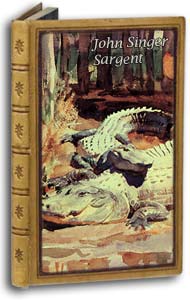John Singer Sargent Book – Technique, Life, Letters and Paintings
ArtGraphica has just released another art book, this time a chronology of American artist John Singer Sargent, following his life, paintings and personal correspondences with such friends as Claude Monet.
Amongst the anecdotes is a retelling of an incident that occured in England, when John Sargent innocently rode his horse through a wheat field to get to a bridle path. The incensed farmer took grave exception and started verbally abusing Sargent who had already dismounted from his horse and was apologising to the man. Sargent could say nothing to appease the farmer, so continued on to the bridle path. The incident, and sense of injustic ate away at him to the point that he took a few boxing lessons and turned up at the farmer’s door. Like a scene from Fawlty Towers, Sargent banged on the door, and demanded the farmer come outside and prepare himself for a damn good thrashing! This was no idle threat, as records report that Sargent had to pay the farmer 50 pounds in compensation for the assault upon him.
For those interested in Sargent’s technique and thoughts on painting, I have assembled a few notes below, but the best information comes from an account by a John Collier. The full text to this account can be found here : John Sargents Painting Technique.
John Singer Sargent was taught by Carolus Duran (of Spanish descent), who insisted Sargent study Velasquez. From this, Sargent learnt how to simplify, beginning with the middle-tone, working up to the darks before dealing with the brightest lights and darkest shadows and accents. Sargent once stated : “If you work on a head for a week without indicating the features you will have learnt something about the modelling of the head.” Whilst his work may appear ‘simple’, and spontaneous, John Sargent was known to repaint heads up to a dozen times if he was not happy, such was his quest for perfection.
He was once asked how to avoid false accents, to which he responded: “You must classify the values. If you begin with the middle-tone and work up from it towards the darks — so that you deal last with your highest lights and darkest darks — you avoid false accents. That’s what Carolus taught me. And Franz Hals — it’s hard to find anyone who knew more about oil-paint than Franz Hals — and that was his procedure. Of course, a sketch is different.
To Miss Heyneman who was seeking advice from him, he said: “Begin with Franz Hals, copy and study Franz Hals, after that go to Madrid and copy Velasquez, leave Velasquez till you have got all you can out of Franz Hals.”
When discussing genius in painting he said that the four painters who in his opinion possessed it in a superlative degree were Rembrandt, Titian, Tintoretto and Raphael, and upon Velasquez being suggested, added that no painter exceeded Velasquez in technical skill, but that he was less gifted in his power to interpret “spiritual qualities.”
Never leave ” empty spaces,” every stroke of pencil or brush should have significance and not merely fill in… copy one of the heads by Franz Hals in the National Gallery, then you will get an idea of what I mean by leaving no empty spaces in modelling a head, work at the fine head of the old woman rather than the superficial one of the man, I will come there and give you a criticism and haul you over the coals.
Sure enough a few days later he appeared at the National Gallery, stating “Don’t concentrate so much on the features… they are only like spots on an apple… paint the head… now you have only nose, mouth and eyes.”
His criticisms were often trenchant. “That’s not a head,” he would say, “that’s a collection of features.” “That’s not a shadow, that’s a hole, there is light in the darkest shadow.” But though often severe, he never discouraged.
Other titbits of information include:
“You want plenty of paint to paint with.”
He put out enough paint so it seemed for a dozen pictures. “Painting is quite hard enough” he said “without adding to your difficulties by keeping your tools in bad condition. You want good thick brushes that will hold the paint and that will resist in a sense the stroke on the canvas.”
To read the book in full, please see this link : John Singer Sargent

